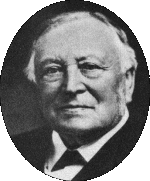Henry Enfield Roscoe
|
|
Sir Henry Enfield Roscoe (January 7, 1833 - 1915) English chemist, was born in London. After studying at Liverpool High School and University College, London, he went to Heidelberg to work under Robert Bunsen, of whom he became a lifelong friend. In 1857 he was appointed to the chair of chemistry at Owens College, Manchester, where he remained for thirty years, and from 1885 to 1895 he was M.P. for the south division of Manchester. He served on several royal commissions appointed to consider educational questions, in which he was keenly interested, and from 1896 to 1902 was vice-chancellor of London University. He was knighted in 1884. His scientific work includes a memorable series of researches carried out with Bunsen between 1855 and 1862, in which they laid the foundations of comparative photochemistry. In 1867 he began an elaborate investigation of vanadium and its compounds, and devised a process for preparing it pure in the metallic state, at the same time showing that the substance which had previously passed for the metal was contaminated with oxygen and nitrogen. He was also the author of researches on niobium, tungsten, uranium, perchloric acid, the solubility of ammonia, etc. His publications include, besides several elementary books on chemistry which have had a wide circulation and been translated into many foreign languages, Lectures on Spectrum Analysis (1869); a Treatise on Chemistry (the first edition of which appeared in 1877-1892); A New View of Daltons Atomic Theory, with Dr Arthur Harden (1896); and an Autobiography (1906). The Treatise on Chemistry, written in collaboration with Carl Schorlemmer (1834-1892), who was appointed his private assistant at Manchester in 1859, official assistant in the laboratory in 1861, and professor of organic chemistry in 1874, has long been regarded as a standard work.

